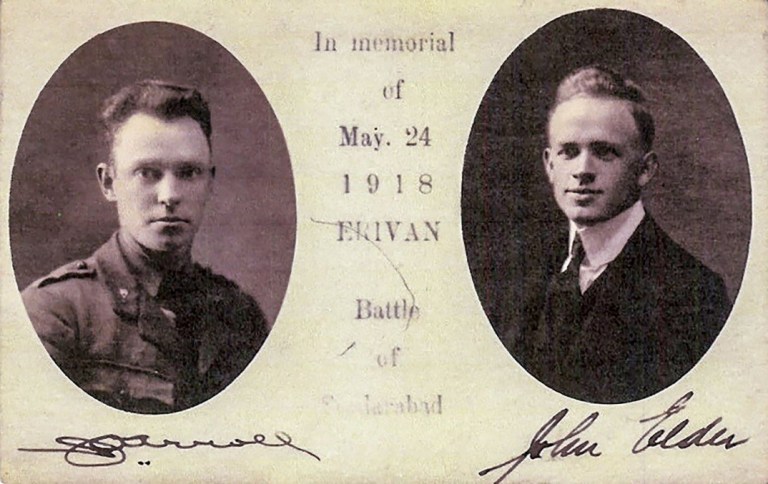CSUN Exhibit Highlights Role YMCA, Americans Played in Armenian Relief Efforts Following World War I

James O. Arroll (left) and John Elder (right)
Americans John Elder and James O. Arroll were in Yerevan, Armenia, in January 1918 to open a YMCA center. Military reversals left the two men responsible for U.S. humanitarian operations in the nascent republic of Armenia as World War I wound down and the republic struggled to recover.
A new exhibit, “The Lifesavers: American Humanitarianism and YMCA Philanthropy in Armenia 1918-1920,” opening Saturday, Oct. 26, at California State University, Northridge showcases the work Elder and Arroll did as the only Americans left in Armenia’s capital city near the end of World War I. It also highlights the work of other Americans who joined the relief efforts once a semblance of peace was established.
“The Lifesavers: American Humanitarianism and YMCA Philanthropy in Armenia 1918-1920” runs through Nov. 7 in the West Gallery of the CSUN Art Galleries, located off Plummer Street, just east of Etiwanda Avenue. To mark the exhibit’s opening, a special program and reception will be held from 3 to 5 p.m. on Oct. 26 in the West Gallery.
“This is an impressive and dramatic exhibit that addresses the consequences of the Armenian genocide and the important role American humanitarians played in relieving the plight of the survivors,” said Vahram Shemmassian, director of CSUN’s Armenian studies program. “As the exhibit makes evident, there were so many American relief workers, who came to the aid of the Armenians in those tragic times, that we still don’t have a full picture of their contributions. They were the best exemplars of American philanthropy whose role in making the world a better place should be better known.”

Children in a government orphanage.
The exhibit’s West Coast premiere is the result of a collaborative effort between the CSUN; the Armenian National Institute (ANI), an educational charity based in Washington, D.C. dedicated to the study, research and affirmation of the Armenian Genocide; the Armenian Assembly of America; and the YMCA of Metropolitan Los Angeles.
“The Lifesavers: American Humanitarianism and YMCA Philanthropy in Armenia 1918-1920” features 95 images, including 64 from John Elder’s collection; eight contemporaneous records and documents; four maps; and excerpts from Elder’s journal that offer insights into life during the first year of the newly independent Armenian republic in 1918.
Elder and Arroll were caught unaware when, shortly after they arrived in Yerevan to set up the YMCA center in January 1918, all communication to the outside world was cut off as the Allied efforts on the Caucasus front faltered during the final months of World War I. By the time they left Yerevan in August 1919, the men had become responsible for the entire humanitarian operation set up by American-based charities, which ultimately earned them a special tribute from then-U.S. President Herbert Hoover.
Among those Americans who eventually joined them in Armenia to work on relief efforts were John H.T. Main, president of Grinnell College in Iowa, who witnessed the horrific conditions in Armenia firsthand on behalf of the American Committee for Relief in the Near East (now the Near East Foundation); respected Christian missionary Grace Knapp; and Walter George Smith, president of the American Bar Association, who became the most vocal American Catholic advocate for the Armenian people at the time. John Mott, longtime president of the American YMCA, who, at the encouragement of his friend, President Woodrow Wilson, dispatched young Americans wherever they could lend civilian support behind the front to soldiers in combat, was especially proud of Elder and Arroll’s achievements in Armenia.
For more information about the exhibit, visit ANI’s website https://www.armenian-genocide.org/files/american_relief.pdf.

 experience
experience